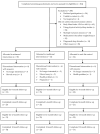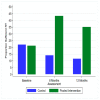Efficacy of a Multi-component m-Health Weight-loss Intervention in Overweight and Obese Adults: A Randomised Controlled Trial
- PMID: 32859100
- PMCID: PMC7503928
- DOI: 10.3390/ijerph17176200
Efficacy of a Multi-component m-Health Weight-loss Intervention in Overweight and Obese Adults: A Randomised Controlled Trial
Abstract
Background: This study compared the efficacy of two multi-component m-health interventions with a wait-list control group on body weight (primary outcome), and secondary outcomes of cardiovascular risk factors, lifestyle behaviours, and mental health.
Methods: Three-arm randomised controlled trial (Enhanced: physical activity, diet, sleep, Traditional: physical activity, diet, Control) with assessments conducted at baseline, 6 and 12 months. Participants (n = 116) were overweight or obese adults aged 19-65 (M = 44.5 [SD = 10.5]). The 6-month intervention was delivered via a smartphone app providing educational materials, goal-setting, self-monitoring and feedback, and also included one face-to-face dietary consultation, a Fitbit and scales. The trial was prospectively registered and conducted between May 2017 and September 2018. Group differences on primary and secondary outcomes were examined between the Pooled Intervention groups (Pooled Intervention = Enhanced and Traditional) and Control groups, and then between Enhanced and Traditional groups.
Results: Nineteen participants (16.4%) formally withdrew from the trial. Compared with the Control group, average body weight of the Pooled Intervention group did not differ at 6 (between-group difference = -0.92, (95% CI -3.33, 1.48)) or 12 months (0.00, (95% CI -2.62, 2.62)). Compared with the Control group, the Pooled Intervention group significantly increased resistance training (OR = 7.83, (95% CI 1.08, 56.63)) and reduced energy intake at 6 months (-1037.03, (-2028.84, -45.22)), and improved insomnia symptoms at 12 months (-2.59, (-4.79, -0.39)). Compared with the Traditional group, the Enhanced group had increased waist circumferences (2.69, (0.20, 5.18)) and sedentary time at 6 months (105.66, (30.83, 180.48)), and improved bed time variability at 12 months (-1.08, (-1.86, -0.29)). No other significant differences were observed between groups.
Conclusions: Relative to Controls, the Pooled Intervention groups did not differ on body weight but improved resistance training, and reduced energy intake and insomnia symptom severity. No additional weight loss was apparent when targeting improvements in physical activity, diet and sleep in combination compared with physical activity and diet.
Keywords: adult; diet; m-health; physical activity; sleep; weight loss.
Conflict of interest statement
The authors and principal investigators of this study declare no conflict of interest.
Figures






References
-
- Jensen M.D., Ryan D.H., Apovian C.M., Ard J.D., Comuzzie A.G., Donato K.A., Hu F.B., Hubbard V.S., Jakicic J.M., Kushner R.F., et al. 2013 AHA/ACC/TOS Guideline for the Management of Overweight and Obesity in Adults. A Report of the American College of Cardiology/American Heart Association Task Force on Practice Guidelines and The Obesity Society. Circulation. 2014;129:S102–S138. doi: 10.1161/01.cir.0000437739.71477.ee. - DOI - PMC - PubMed
-
- National Health and Medical Research Council . Summary Guide for the Management of Overweight and Obesity in Primary Care. National Health and Medical Research Council; Melbourne, Australia: 2013.
-
- Hutchesson M.J., Rollo M.E., Krukowski R., Ells L., Harvey J., Morgan P.J., Callister R., Plotnikoff R., Collins C.E. eHealth interventions for the prevention and treatment of overweight and obesity in adults: A systematic review with meta-analysis. Obes. Rev. 2015;16:376–392. doi: 10.1111/obr.12268. - DOI - PubMed
-
- Aguiar E.J., Morgan P.J., Collins C.E., Plotnikoff R.C., Callister R. Efficacy of interventions that include diet, aerobic and resistance training components for type 2 diabetes prevention: A systematic review with meta-analysis. Int. J. Behav. Nutr. Phys. Act. 2014;11:2. doi: 10.1186/1479-5868-11-2. - DOI - PMC - PubMed
Publication types
MeSH terms
LinkOut - more resources
Full Text Sources
Medical

